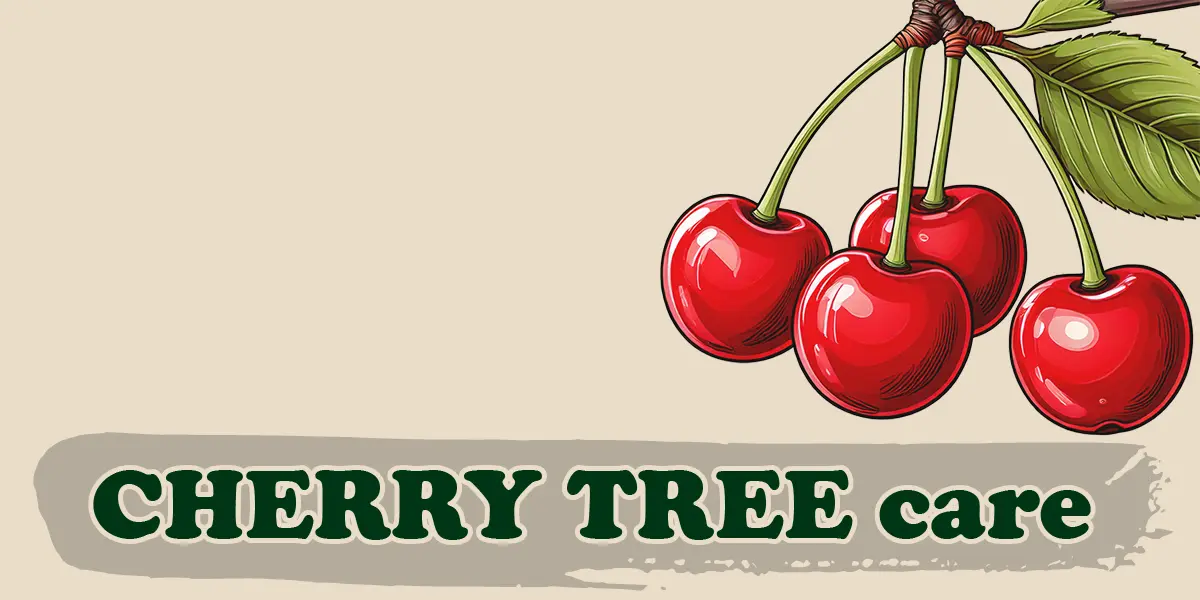Young George Washington never chopped down a cherry tree. An early biographer fabricated the story — a lie to illustrate Washington’s love of the truth.
Washington was a Virginian, and Virginia was a prime area for cherry cultivation at the time. But the trees grow just as well in metro LA, and most US cherry farming occurs on the West Coast. California ranks second in US cherry production, with approximately 80,000 tons annually. Virginia’s current cherry production is too small to be reported in national agricultural statistics.
Cherry trees originated in temperate parts of Europe and Asia. They’re prominent in ancient art and literature and continue to be revered for their beauty, shade, wood, and delicious fruit.
The fruit sometimes arrives at the grocery store soft and bland, picked early and transported long distances. Not so when you harvest them fresh off the tree in your backyard!
The Cherry Tree in Japan
The cherry tree holds an exalted place in Japanese culture.
- The Japanese word for cherry blossom is “sakura.” It symbolizes renewal and the fleeting nature of life.
- Hanami is the tradition of flower viewing. During cherry blossom season, people gather under the cherry trees lining walkways and parks to appreciate their beauty.
- The cherry blossom is prominently featured in Japanese art, like paintings, poetry, and fashion.
Clearly, the Japanese know a great fruit tree when they see one. Below are guidelines to cultivate that tradition in your California yard.
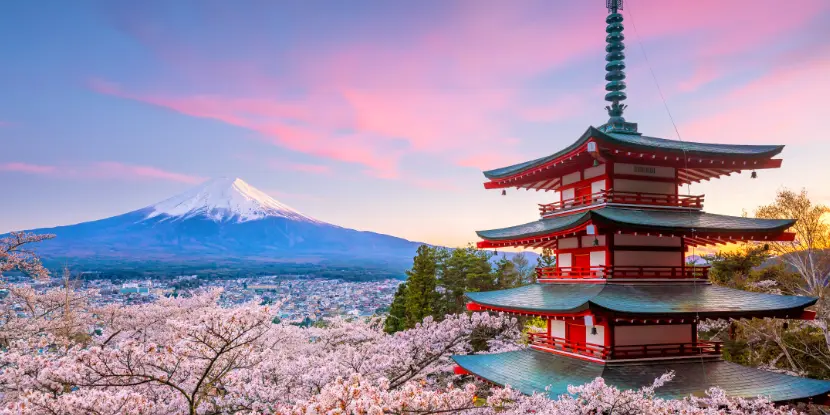
Blooming Japanese cherry trees with Mt. Fuji in the background.
Choosing a Variety for Southern California
You’ll want a variety that flourishes in mild winters and hot summers.
- Bing: A dark red, sweet cherry that requires minimal chill hours (hours of cold temperatures needed for fruit production).
- Royal Lee: A self-fertile variety with large, juicy cherries that need only 200 chill hours.
- Rainier: A yellow and red speckled cherry with a sweet flavor and low chilling requirement.
- Lapins: A heat-tolerant, self-fertile cherry that produces large, dark red fruit with a high sugar content.
- Stella: A popular self-fertile variety that ripens early and produces large, firm cherries. It needs 400 chill hours.
Optimal Growing Conditions
Light
- Cherry must have 6–8 hours of full sun daily.
- Avoid planting them near structures or taller trees that cast shade.
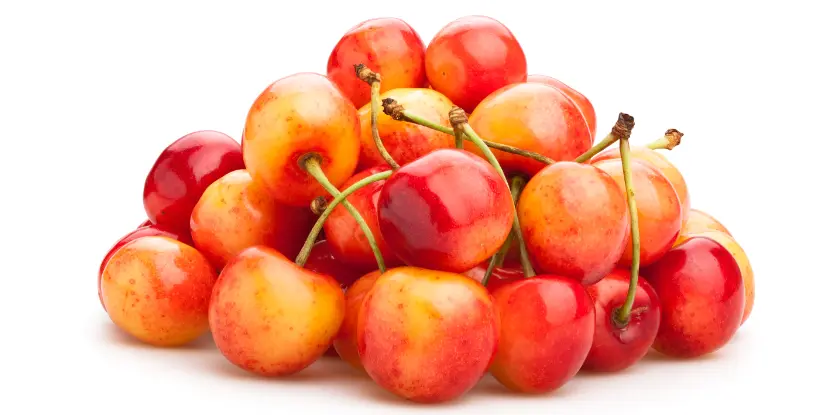
Yellow and red speckled Rainier cherries.
Temperature Range
- Warm varieties adapt well to temperatures ranging from 40°F to 85°F.
- Protect trees during extreme heat waves with shade cloth or extra irrigation.
Soil
- Well-draining soil is critical.
- pH range: 6.0–6.8 for optimal growth.
- Incorporate compost or organic matter for nutrition.
- Avoid heavy clay soils. If needed, elevate the tree bed with a raised planting mound.
Propagating Cherry Trees
Planning to grow cherries from scratch? You have two options:
Buy Bare Root Trees
Bare root trees are dormant and ready to plant in winter.
Grafting
For the expert gardener, grafting different cherry varieties onto rootstock can produce healthy and productive trees.
Seed propagation isn’t ideal for cherries. It’s a slow, unpredictable route that doesn’t ensure fruit quality or adaptability to a warm climate.
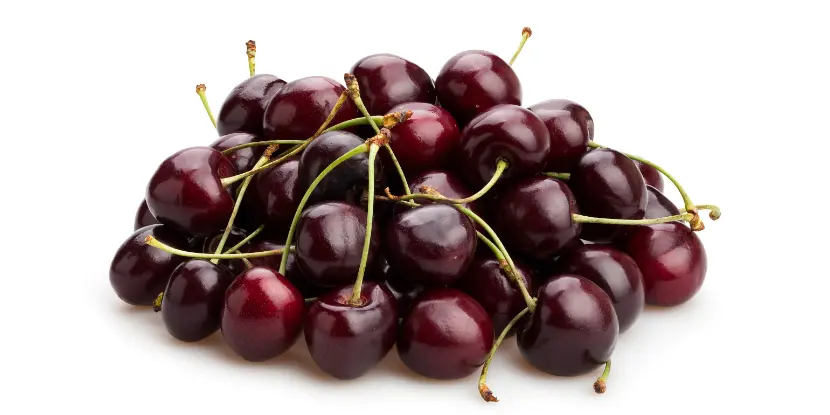
Ripe Bing cherries with their deep burgundy coloring.
Steps for Planting a Cherry Tree
The best time to plant is during late winter to early spring when the tree is still dormant. This gives the tree ample time to establish roots before the growing season.
Planting in late fall is also possible for regions with mild winters. The cooler weather allows the roots to settle before the summer heat.
Avoid planting during periods of frost or in soggy soil conditions, which can hinder the young tree’s initial development.
- Pick a sunny area with good air circulation.
- Dig a hole twice as wide as the root ball and the same depth as the container.
- Mix the native soil with compost to improve drainage and fertility.
- Place the tree in the hole, with the root collar at soil level.
- After planting, water thoroughly to settle the soil around the roots.
- Spread 2–4 inches of mulch around the base, keeping it away from the trunk to prevent rot. This helps retain moisture and suppresses weeds.
- If planting in a windy area, use stakes to stabilize young trees.
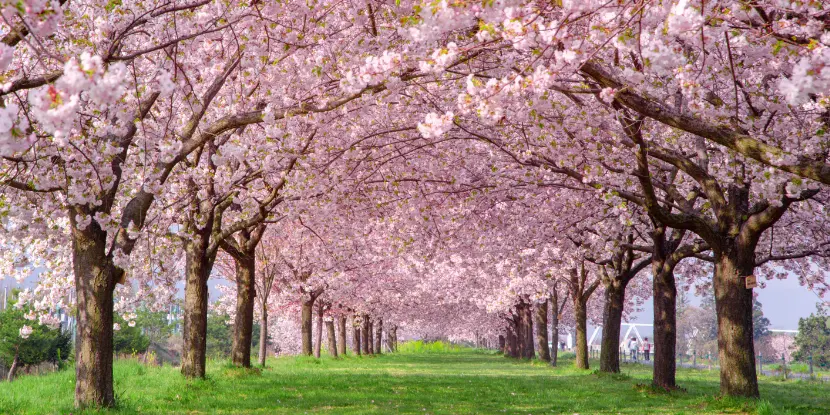
A park lined with blooming cherry trees.
Cherry Tree Care
Water
Cherry trees need regular, deep watering.
- Newly planted trees: Once a week in spring and summer.
- Mature trees: Cut back slightly, but don’t allow drought stress.
Fertilizer
Fertilize twice annually.
- Early spring (before flowering): Use a fertilizer with nitrogen.
- Mid-summer (after harvest): Use a balanced fertilizer to support next year’s growth.
Pests & Diseases
- Aphids or borers: Treat with insecticidal soap or neem oil.
- Fungal diseases like brown rot: Prevent with good airflow and proactive pruning.
Pruning
- Prune in late winter or early spring.
- Remove dead or diseased branches.
- Maintain an open canopy for better light penetration.
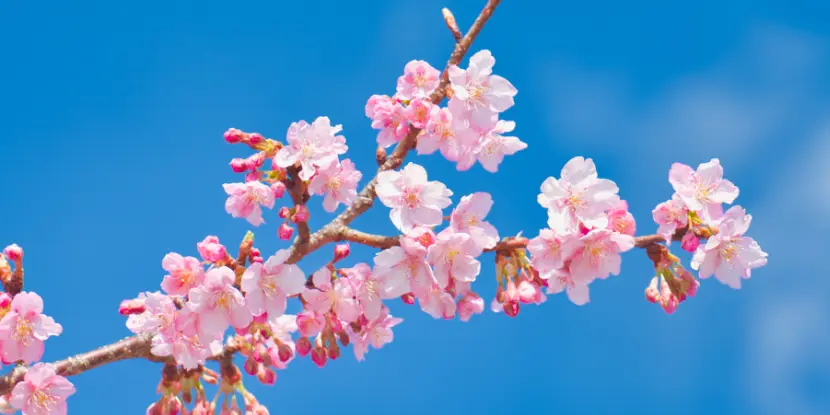
A close-up of pink cherry blossoms.
Harvesting Cherries
- Expect cherries after 3–5 years post-planting.
- Harvest when the fruit is firm and fully colored to maximize sweetness.
Enjoy them immediately! Cherries have a shorter shelf life than most other fruits.
Growing Cherry Trees in Pots
Growing cherry trees in pots is a great option if you don’t have a large yard or live in an area with harsh winters.
- Choose a dwarf variety that will fit comfortably in a pot with drainage holes.
- Use a well-draining potting mix that retains some moisture but doesn’t get soggy.
- Avoid garden soil, which can compact in pots and hamper root development.
- Place the pot in a sunny location and water regularly.
- Fertilize during the growing season with a balanced fertilizer.
- Prune regularly to maintain size and shape.
- Potted cherry trees must go dormant for a time before bearing fruit.
- During the winter, expose them to cold (around 40°F).
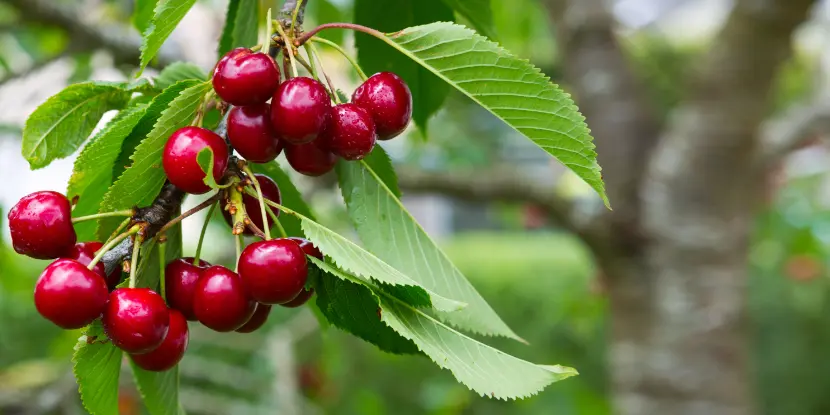
Bing cherries ripening on the tree.
FAQs: Cherry Tree Care
Q: Do cherry trees grow fast?
Cherry trees grow about 1–2 feet annually. Dwarf or semi-dwarf varieties grow at a slightly slower pace.
Q: How long do cherry trees live?
Cherry trees live around 20–30 years under good care. Some ornamental varieties live longer but don’t produce fruit.
Can cherry trees survive heat waves?
Yes, with extra attention. Mulching, drip irrigation, and shade cloth help cherries endure high temperatures.
Q: Is it easy to grow cherries in containers?
Yes. Pick dwarf varieties like Stella for containers. Use a large pot for root space, and ensure excellent drainage.
Q: Do I need two trees for cherries?
Not always. Self-pollinating varieties like Lapins and Stella don’t need partners, but others like Minnie Royal must have a pollinator.

